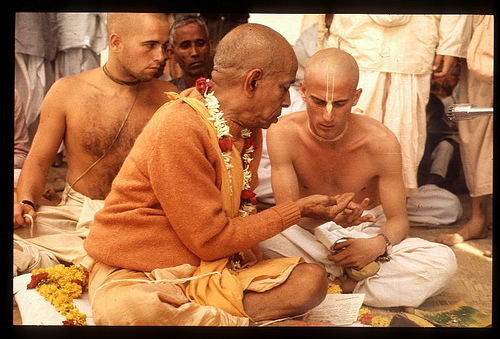Aspects of a Successful Parampara
By Kripamoya Das | Dec 28, 2012

When one thousand people in the United States were asked the question: “What factors brought you to your present religious belief and membership of your current religious community?” the overwhelming majority, 85%, responded that ‘my friend got me interested,’ or ‘my friend was already involved,’ or ‘I went along to the meetings with friends.’ The findings of this survey suggest that a prime influence in religious self-identification (other than deeply-held personal conviction) is our circle of friends; and what we believe then influences our subsequent choices of friends. The committed relationships we maintain with our circle of friends also seem to be a key ingredient in the expansion, socialisation and sustainability of a religious community.
There will always be highly motivated, self-starting, lone seekers of spiritual wisdom. After a mystical experience, or a deeply heart-warming reading of an ancient text, and armed with only their own initial inspiration, they’ll search out a spiritual practitioner who can share his or her wisdom. They may even join a small, very dedicated, band of austere followers. In India it was formerly quite common for a guru to impart rahasya-vidya, secret teachings, to a handful of such disciples, sometimes only one or two. Those disciples would then pass on the secret mantras and tantras to another two disciples. Over the generations this would form a small and exclusive parampara; perfectly valid and intact, but not one that would have any far-reaching social consequences.
The paramparas associated with the Vaishnava community are, in contrast, dedicated to widespread dissemination of knowledge and practice. They are based upon the compassionate uplifting of humanity with the message of the most merciful incarnations and messengers of God. As such, the mantra – at least the particular parampara’s ‘great mantra’ – is distributed to all comers, irrespective of any material or social consideration. It is this friendship to all – the creation of lines of friendship so important to the socialisation of a religious message – that guarantees the widespread popularity of Vaishnavism and its endurance across the centuries.
Although a parampara is simply the handing down of knowledge from teacher to student – guru to sisya – it also generates a parallel manifestation due to its reaching out in friendship to others: a self-perpetuating community of spiritual friends that forms a distinct social grouping, steadily growing down through many centuries.
The authentic teachings of Vaishnavism in written form have become essential in perpetuating a parampara. For this reason modern-day Vaishnavas of ISKCON have digitized the founder-acarya’s teachings, audio recordings and visual images, and provided bomb-proof, museum-level archives for the original materials. Without preservation of the original teachings there would inevitably be philosophical divergence at some point in the future, threatening the perpetuation of the parampara.
But the other elements that serve to sustain a parampara are those that were amply demonstrated by the acarya himself. Firstly, the personal appearances: individual teaching and lecturing – upadesha and upanyasa – with guidance, correction, encouragement, and enthusiasm given to disciples by a living preceptor. Second, the formation of branches of the community, physical places where, in a dedicated environment, followers may gather together for prayer, meditation, worship and discussions. Third, the utter dedication to reaching out to others in a spirit of friendship: free hot meals of sacred food, theatre and colourful festivals, singing processions and sales of philosophical books in accessible language. It is difficult to imagine the present success of ISKCON without these components so generously arranged by the founder.
The sustainability of the parampara would thus seem to be best guaranteed by the preservation of the teaching; the living presence of the exemplars of the teaching; the proliferation of physical spaces where the practices of spirituality can prosper, and the spirit of reaching out to others. And of course, if everyone can remain friends then success is assured.












